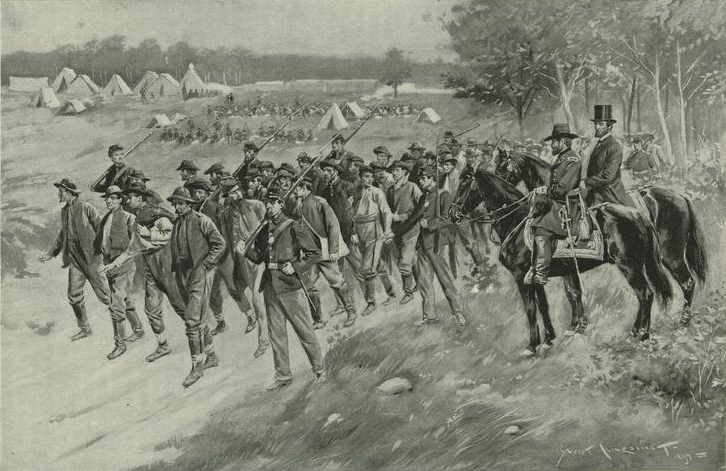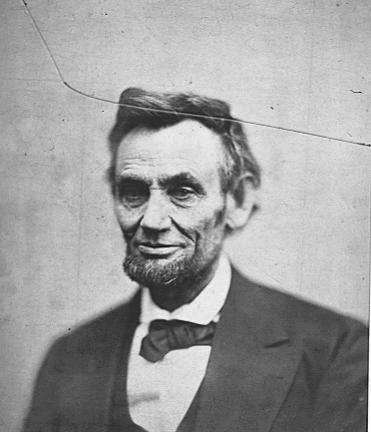“The best dispatch you can show me”: Lincoln Reviews the Fort Stedman Prisoners
 “The time had arrived when all, from Generals Grant and Meade to those of the rank and file, were conscious that the final struggle was near,” claimed a Vermont soldier in late March 1865. The Union noose around Petersburg slowly tightened; Phil Sheridan’s cavalry expected to arrive any day and Bill Sherman’s army slightly farther away on the April horizon. Abraham Lincoln wanted to be with the army in what many believed would be the climactic campaign and boarded the steamer River Queen on March 23 and arrived the next day at Union headquarters at City Point. Before the President, with his wife and son Tad, could settle in with a planned military review on the 25th, a desperate but doomed Confederate charge kickstarted the war in Virginia’a final sequence of events.
“The time had arrived when all, from Generals Grant and Meade to those of the rank and file, were conscious that the final struggle was near,” claimed a Vermont soldier in late March 1865. The Union noose around Petersburg slowly tightened; Phil Sheridan’s cavalry expected to arrive any day and Bill Sherman’s army slightly farther away on the April horizon. Abraham Lincoln wanted to be with the army in what many believed would be the climactic campaign and boarded the steamer River Queen on March 23 and arrived the next day at Union headquarters at City Point. Before the President, with his wife and son Tad, could settle in with a planned military review on the 25th, a desperate but doomed Confederate charge kickstarted the war in Virginia’a final sequence of events.
Robert E. Lee recognized that to stand still meant death for the Confederate cause. He called upon Maj. Gen. John Brown Gordon to formulate a plan to loosen the northern grip. If the Army of Northern Virginia could muster the strength to threaten the military railroad that ran behind the Union trenches at Petersburg, Grant might have to abandon his lines south and southwest of the city. This would provide Lee with the much needed breathing room to send a portion of the army directly south to lend their weight in slowing Sherman. It was a risky maneuver but about the only one left for the Confederate high command.
Gordon selected Fort Stedman, which protected Meade Station on the Union supply line, for the assault. His initial plan called for an early morning assault that committed half the Confederate infantry. While his careful preparations and small unit tactics succeeded in breaching the Union lines and temporarily gaining control of Fort Stedman early on March 25, most of the massed Confederate infantry columns who were to follow did not move forward until too late, if at all.
The Union IX Corps capitalized on the failed offensive and captured several thousand prisoners in a swift counterattack that morning that stabilized the front. For a few hours, however, confusion reigned in the Union ranks as generals rushed reinforcements to the eastern front while scrounging for tactical updates.
Still aboard the River Queen at City Point that morning, President Lincoln did not hear of the battle until his son Robert came in and reported the battle still in progress but favoring the Union army. Lincoln quickly wrote a note on to Secretary of War Edwin M. Stanton that described the fight as “a little rumpus up the line.”
After finishing breakfast, Lincoln set off for Grant’s headquarters at the Eppes plantation and learned of the severity of the engagement. He asked to see the battlefield for himself, a request that Grant had to deny. Still yearning for information, Lincoln boarded a train on the fully operational military railroad and rode with his wife and Gen. and Mrs. Grant for Patrick Station and Meade’s headquarters.
While waiting for the Army of the Potomac’s commander to emerge, Lincoln noticed a large group of Confederate prisoners from Fort Stedman gathered about. “Really these men possess a capacity for looking ‘rough’ beyond any people I ever saw,” described Lieutenant Colonel Theodore Lyman, of Meade’s staff, of the prisoners. “They grew rougher and rougher. These looked brown and athletic, but had the most matted hair, tangled beards, and slouched hats, and the most astounding carpets, horse-sheets and transmogrified shelter-tents for blankets, that you ever imagined.”
Lyman, too, had a mixed attitude about his Commander-in-Chief’s physical appearance:
The President is the ugliest man that ever saw, lank and peaked featured, with an expression of comic vulgarity. Yet his face is full of concentrated shrewdness & humanity; and, indeed, the heavy folds of his eye give almost a look of genius. His appearance altogether is that of a highly intellectual and honest Satyr!

“I never wish to see him again,” Lyman admitted, but conceded, “I am well content to have him at the head of affairs.”
Eventually Meade emerged with a dispatch from IX Corps commander, Maj. Gen. John G. Parke, detailing Stedman’s recapture. “Ah, there is the best dispatch you can show me from General Parke,” Lincoln declared, pointing at the prisoners.
Continuing onward, Lincoln took time to finally review just a division in the V Corps. “As the Chief Magistrate rode down the ranks, plucking off his hat gracefully by the hinder part of the brim, the troops cheered quite loudly,” recalled Lyman. As the festivity drew to a close, the booming of the cannon at Fort Fisher to the west signaled once more the resumption of hostilities.
Meade had recognized that the frantic assault on Petersburg’s eastern front necessarily stripped troops of the southern lines on the western front. He ordered the II and VI Corps to test the Confederate lines along Boydton Plank Road down to Hatcher’s Run. The bluecoats succeeded in pushing back their picket counterparts back onto the main line but did not attempt an assault against the earthworks.
While the VI Corps attacked that afternoon, Lincoln and his guests traveled to Fort Wadsworth, where they could watch the Union charge. A Vermont private commented on the group’s visit with similar sentiments as Lyman:
The President, Gens Grant, Meade, and Wright were riding around during the day “taking observations.” They were here to the fort opposite our camp over half an hour, and I had a good chance to see “Uncle Abe,” and I believe he is the homliest man I have seen for three years. But I guess he is good natured, for he was a grinning all the time he was here.
Clearly the pressures of the past year had visibly imprinted themselves on the nation’s leader, as described previously by Chris Mackowski. However, an examination of the primary sources suggests that many soldiers held their Commander-in-Chief in even higher regard now that peace seemed closer on the horizon as the Confederate army dwindled away.
I very much liked the article, but unlike many of my past comments, I would have liked more detail of the actual attempt by Gordon to take Fort Stedman and then the battle that ensued to retake it by Union forces.
I certainly agree that Fort Stedman merits more attention but unfortunately my time forces me to stay focused on Petersburg’s western front. Some really good recent scholarship on Fort Stedman, however, can be found in Volume 25, Issue 1 of Blue & Gray Magazine.
To add to Edward’s point, there’s also an essay about the Battle of Fort Stedman in Ed Bearss’ second Petersburg book, put out by SavasBeatie.